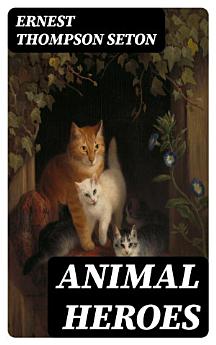Animal Heroes
Ernest Thompson Seton
Sep 2022 · DigiCat
Ebook
135
Pages
family_home
Eligible
info
reportRatings and reviews aren’t verified Learn More
About this ebook
In "Animal Heroes," Ernest Thompson Seton masterfully weaves together the realms of zoology and storytelling, recounting the lives of remarkable animals that exhibit extraordinary intelligence, courage, and spirit. Through a blend of vivid narrative and keen observation, Seton employs a naturalistic style, immersing readers in the trials and triumphs of his animal subjects. The book embodies the early 20th-century revival of interest in nature literature, reflecting the burgeoning movement towards wildlife conservation and the reverence for the natural world, making it a foundational text in this genre. Seton, a prominent figure in the early conservation movement and a founder of the Boy Scouts of America, drew upon his own deep appreciation for animals, honed during his extensive travels across North America. His background as a naturalist and artist allows him to create not just a narrative, but a heartfelt homage to the creatures he portrays. Seton's compassion for his subjects stems from a profound understanding of their lives, inspiring readers to see the world from an animal's perspective and fostering empathy for all living beings. "Animal Heroes" is a must-read for nature enthusiasts, animal lovers, and anyone who appreciates finely crafted tales of heroism. Seton's engaging prose and relatable themes invite readers to ponder the often-overlooked narratives of the animal kingdom while promoting a message of respect and stewardship towards nature. This book not only entertains but also educates, making it an essential addition to any literary collection.
About the author
Ernest Thompson Seton (1860–1946) was a pivotal figure in the transition from the 19th to the 20th century's approach to wildlife, storytelling, and the intersection of nature with human culture. An artist, naturalist, and writer, Seton was born in South Shields, England, but his family moved to Canada when he was six, which greatly influenced his affinity for the wilderness. His most renowned work, 'Animal Heroes' (1905), epitomizes his unique literary style — a blend of scientific observation with emotive narrative that has captivated readers by personifying animals in the wild. The book is a collection of stories that not only highlight the nobility of animals but also offer profound insights into their instincts and behaviors, serving to bridge the gap between humans and wildlife in a manner that was innovative at the time. Seton was a forerunner of the modern environmental movement, and his foundational role in the establishment of the Boy Scouts of America illustrates his commitment to educating youth on the importance of nature. Moreover, he was a prominent figure in wildlife conservation, advocating for ethical treatment of animals and emphasizing wildlife management, which was reflected through his literary contributions. His works remain significant in the canon of environmental literature, resonating with themes of empathy and understanding toward all living beings. Seton's storytelling and advocacy laid the groundwork for future conservationists and nature writers, making his contributions to literature and wildlife preservation enduringly influential.
Rate this ebook
Tell us what you think.
Reading information
Smartphones and tablets
Install the Google Play Books app for Android and iPad/iPhone. It syncs automatically with your account and allows you to read online or offline wherever you are.
Laptops and computers
You can listen to audiobooks purchased on Google Play using your computer's web browser.
eReaders and other devices
To read on e-ink devices like Kobo eReaders, you'll need to download a file and transfer it to your device. Follow the detailed Help Center instructions to transfer the files to supported eReaders.








